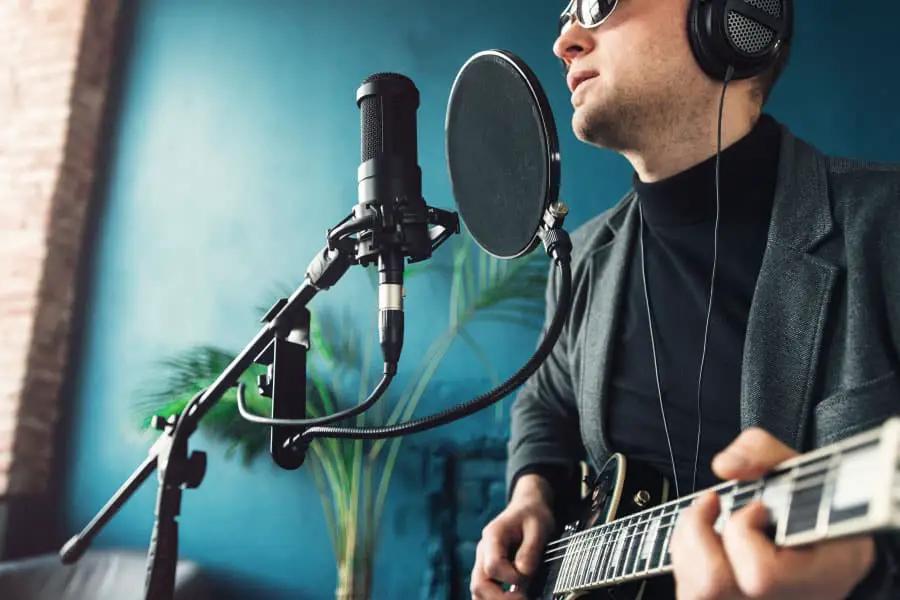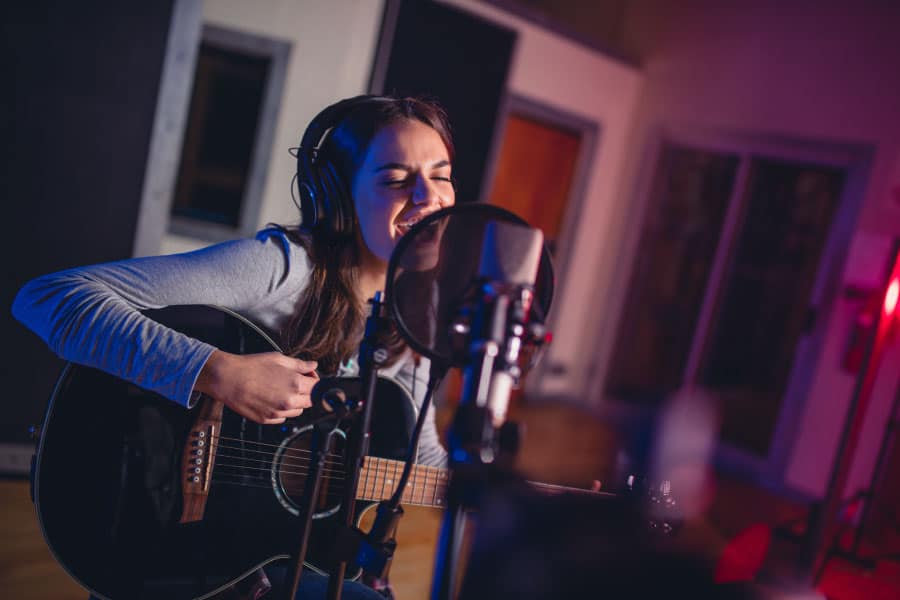
I have recorded a ton of musicians together and separately for guitar and vocals, including myself. I’ve been asked if it really matters, and I have gotten into a few heated arguments where I stand by my statement of “you should always record them separately.” Here is an in-depth article on recording guitar and vocals together, separately, and some other useful information on recording the two.
It is preferred that you record vocals and guitar separately. Most professional studios and producers stand by it because more complications can arise when recording them together, such as timing and mistakes. Recording parts separately gives you the precision to listen, focus, and create the best possible takes you can. However, recording tracks together could give your tracks more chemistry and feel depending on if the musicians are in sync.
In this article, I will go over how you can record both vocals and guitar, naming some of the gear that I use or have used in my more than 20 years’ worth of experience. Then we will dive into the pros and cons of recording both guitar and vocals separately. Enjoy!
How to record guitar
I have been recording guitar now for over 20 years. My studio has been running for the past decade almost, and in that time when I have had the opportunity to test my guitar recording, I have been lucky enough to have been able to test out many variations in my guitar recording techniques.
Before having my studio, I would do some session work and record parts for albums, jingles, singles, and more. Whenever I did those back in the day, the studio would have certain gear that I could use and nothing else—more on that in a bit.
I’ve broken this section down into three main headings, and I will explain them all in a bit of detail. However, many aspects can affect how you record guitar under these headings but that I will leave for another article.
If you would like some online lessons or courses on the guitar, then be sure to check out our online music academy where we offer courses and lessons on a ton of instruments – Master Music Talent Academy

Recording guitar via direct input into your audio interface
The modern way to record guitar, especially because of the home studio recording revolution, is that you can plug your guitar directly into your audio interface (no amp and microphone required).
You can also achieve this when recording with an acoustic guitar; however, the acoustic guitar has to have pickups in it with a line out. Regular acoustic guitars will have to work the old-fashioned way, and you will need to have a microphone set up to record.
Your audio interface lets you plug directly into it via the jack input, and you will almost always have this type of input on your audio device.
Once you have plugged your guitar into your audio interface, you will have to use your DAW to record the guitar via an audio channel. You can then also use either the DAW’s plugin or a 3rd party plugin that lets you change and choose the desired sound you want for your guitar.
For the most part, this is definitely the easiest way to record; it’s just basically plug and play. One thing to note is that the quality of the guitar comes through here, especially the pickups. I’m lucky enough to have a wide variety of good quality guitars, so the sound recording is always excellent.
The DAW I use is Ableton Live. This is because I produce dance music and use Ableton in live situations for stage (loops, samples, etc.). There are other fantastic DAWS out there that I have used, such as Pro Tools and Cubase, and for the most part, they all get the job done. So, usually, it boils down to preference.
If you have Ableton, then I suggest checking out this book that I used to learn my mixing and mastering skills.
Recording guitar with a microphone and amplifier
I have heard plenty of producers say that the only way to capture the guitar is the old fashioned way you mic up the amplifier and record.
This definitely gives a different feel, sound, and texture to the guitar recordings, and I would recommend it if at all possible. The only problem is you will have to have amazing amplifiers and a variety to choose from to get the sound you are looking for.
Then after that, you are also going to need a good microphone to capture the sound. As you can imagine, the total cost of all this equipment can shoot through the roof almost instantly, and you will only ever find these kinds of setups in professional recording studios.
However, if you have some cash to burn, I recommend these heads, amplifiers, and cabinets. In all my years of playing and recording, these are the best that have always delivered time and time again.
Guitar amplifier Heads
Marshall JVM Series JVM205H 50W Tube Guitar Amp Head Black
Marshall 1959HW Handwired Plexi Head
Guitar Cabinets
Fender Super-Sonic 60 60W 2×12 Guitar Speaker Cabinet Blonde Straight
Guitar Amplifiers
Fender Tone Master Deluxe Reverb 100W 1×12 Guitar Combo Amp Black
Fender Hot Rod Deluxe IV 40W 1×12 Tube Guitar Combo Amplifier Black
Fender ’64 Custom Deluxe Reverb 20W 1×12 Tube Guitar Combo Amp Black
Recording guitar through a rack mount or pedalboard
I love using rack mounts and pedalboards. The cool thing about rackmounts and pedalboards is that you can incorporate them with your audio interface or amplifiers.
For years I used analog pedals and then routed them through whatever amplifier the studio had available for me. Then, when I opened up my own studio, I had the opportunity to purchase some rack mounts, and then I switched to midi controller guitar pedalboards.
With the combination of my midi pedalboards, rack mounts, and 3rd party plugins, I am literally able to get any sound I can dream up. The quality is amazing, the noise is low, there is no interference, and then it also just looks freaking cool.
Some of the gear is use include:

How to record vocals
The only way to record vocals is through a microphone with direct input. You will never record vocals miced up through an amplifier (or at least you should never). However, you can send vocals through effects before the signal hitting the audio interface. These will come usually come (if you are in a professional studio) through the form of rackmounts.
If you would like some online lessons or courses on vocals than be sure to check out our online music academy where we offer courses and lessons on a ton of instruments – Master Music Talent Academy
Recording vocals through your audio interface
As with guitar and other instruments, most audio interfaces (even entry-level ones) will have an XLR input for your mic recording. Depending on what microphone you are using, you may need phantom power, so just be sure you know if you are using a dynamic or condenser microphone.
The same aspect will apply when recording vocals as with a guitar; you just plug in and rout the signal through an audio channel in your DAW and then use plugins to mix and edit your sound.
Recording vocals through rackmounts
A very cool thing and a professional way to record your vocals are using extra processes before recording the audio signal. Usually, the only two “effects” you will use when routing your vocals will come in the form of a compressor and a pre-amplifier.
Audio interfaces do all come with built-in preamps, so there is no need to get one. However, some people like different sounds, and an external preamp will give you the ability to create different tones and textures in your recording without messing with the recorded signal too much.
Check out my article on – Do you need a preamp for an audio interface?, where I go into detail regarding audio interfaces, preamps, and their differences.
I also like to use an external compressor. This helps me with vocalists who have very big dynamic ranges. What is cool is I can compress the signal somewhat to get the vocals more smooth and even before they reach my DAW, so I don’t have to lay on the effects and compressor so much in my DAW that things start to go wild.
All in all, it will boil down to preference and what you can afford. The external compressor and preamp I use on my recordings are:
Samson S-com 4 4-Channel Compressor/Gate
Warm Audio TB12 Black Tonebeast Microphone Preamp

Recording vocals and guitar together
There are two ways we can look at recording guitar and vocals together. One is with a guitar player who records guitar and a separate vocalist who records the vocals.
Another way is if one person plays and sings together. Both of these are very different from one another, and we will take a look at them combined under the next headings.
Pros for recording guitar and vocals together
If you have two separate people recording (guitar player and vocalist), you can consider a few key things that can help your recording. Besides the fact that you should always record with a click (metronome), the guitarist and vocalist will sometimes record better together because they can “feel” one another. That means each can anticipate the other regarding breaks, coming in, feeling, emphasis, direction, and build-ups.
This is because usually, the pair has written the song together, or they have performed it a million times. By doing this, there are slight nuances that you could pick up in your recordings that you wouldn’t get if the two were recorded separately.
If you are recording one person who plays and sings, then the same aspect would apply. They might give a little more energy when recording simultaneously because one talent plays off the other, encouraging and pushing them. Another factor to consider is that they are less stressed and less prone to making mistakes because they feel more comfortable doing both than performing each task individually.
This also holds true when recording a separate vocalist and guitarist together. You get chemistry, which can’t be denied.
Cons for recording guitar and vocals together
The one downside is if the musicians don’t know the song or have a feel for it. They could make mistakes causing you to have to record retakes again and again. even if you the other performed the take immaculately.
The other negative is if the musicians just aren’t that good. This doesn’t mean not knowing the parts well; it just means that their talent lacks a bit. They could have bad timing, and they could not be very proficient in their instrument.
Sometimes, what they will try to do is mask their mistakes by using the other musician as a cushion, and they think it won’t come through the recording (but it does). This is because people feel and hear live music differently from a recording.
Besides being able to or trying to hide their mistakes, another factor to consider is that you might miss some mistakes from either musician because you are more focused on one track than the other.
Pros for recording guitar and vocals separately
Precision. That’s the word I would use when you can record parts for a track separately. For the most part, a professional musician will not have a problem with this and would mostly prefer this.
A pro musician will give the best of their ability, and you won’t really notice that the chemistry is gone (when recording simultaneously) from their parts because they know how the song goes and should go, and they have chops.
Working with pros on this level is great cause you can just set up the click, get the sound they want, and hit record. For the most part, they will only need to do a handful of takes if they don’t get it right on the first go.
The other factor to consider is you can put all your effort into listening to the individual track recorded. You can focus and pick up little nuances, discrepancies, or mistakes, and if the musician is willing to help you get the best take, you as a producer can tell them to put more or less in different sections, coming up with new ideas and being able to create the best take possible.
Cons for recording guitar and vocals separately
Sometimes, if you are working with musicians who can hold their own, they get a bit nervous when recording. This usually has nothing to do with their playing ability but rather their nerves, and they will feel like they are under a microscope when the record switch turns red.
Due to their nerves, sometimes, their playing is very robotic, and they underperform and just try to get a track right rather than playing with feel. You can mitigate this by recording the parts repeatedly until they get comfortable, but remember, this takes time, and time is money.
Conclusion
So we figured out that there are a few ways you can record vocals and guitar, and I gave you some of the gear that I use. If you record vocals and guitar, you should look into these various aspects because they will help you record better, whether you record vocals and guitar together or separately.
There are pros and cons to recording guitar and vocals together and separately, and you would have to consider these factors when you are working with musicians of a certain caliber.
However, I always push to record tracks separately so I know I’m getting a good clear, precise, and focused track. If the musician you are working with is uncomfortable, then reassure them and record the track multiple times so they can relax, get comfortable, and put some feeling into it.

